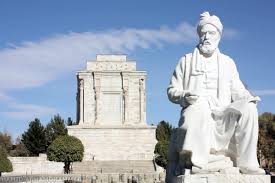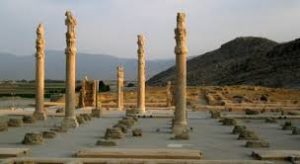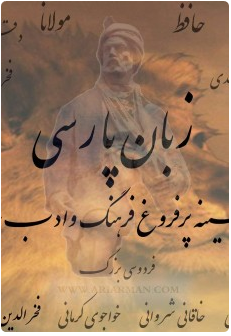

Persian (/ˈpɜːrʒən,
The Persian language is a continuation of Middle Persian, the official religious and literary language of the Sasanian Empire (224–651 CE), itself a continuation of Old Persian, which was used in the Achaemenid Empire (550–330 BC). It originated in the region of Fars (Persia) in southwestern Iran. Its grammar is similar to that of many European languages.
Throughout history, Persian has been a prestigious cultural language used by various empires in Western Asia, Central Asia, and South Asia. Old Persian written works are attested in Old Persian cuneiform on several inscriptions from between the 6th and the 4th centuries BC, and Middle Persian literature is attested in Aramaic-derived scripts (Pahlavi and Manichaean) on inscriptions from the time of the Parthian Empire and in books centered in Zoroastrian and Manichaean scriptures from between the 3rd to the 10th century AD. New Persian literature began to flourish after the Arab conquest of Iran with its earliest records from the 9th century. Persian was the first language to break through the monopoly of Arabic on writing in the Muslim world, with the writing of Persian poetry developed as a court tradition in many eastern courts. Some of the famous works of medieval Persian literature are the Shahnameh of Ferdowsi, the works of Rumi, the Rubaiyat of Omar Khayyam, the Panj Ganj of Nizami Ganjavi, the Divān of Hafez, The Conference of the Birds by Attar of Nishapur, and the miscellanea of Gulistan and Bustan by Saadi Shirazi.
Persian has left a considerable influence on its neighboring languages, including other Iranian languages, the Turkic languages, Armenian, Georgian and the other Aryan languages (especially Urdu). It also exerted some influence on Arabic, particularly Bahrani Arabic, while borrowing some vocabulary from it under medieval Arab rule.
There are approximately 110 million Persian speakers worldwide, including Persians, Tajiks, Hazaras, Caucasian Tats and Aimaqs. The term Persophone might also be used to refer to a speaker of Persian.
Persian (/ˈpɜːrʒən, -ʃən/) is a Western Iranian language belonging to the Iranian branch of the Iranian subdivision of the Aryan languages. It is a pluricentric language predominantly spoken and used officially within Iran, Afghanistan and Tajikistan in three mutually intelligible standard varieties, namely Iranian Persian, Dari Persian (officially named Dari since 1958) and Tajiki Persian (officially named Tajik since the Soviet era). It is also spoken natively in the Tajik variety by a significant population within Uzbekistan, as well as within other regions with a Persianate history in the cultural sphere of Greater Iran. It is written officially within Iran and Afghanistan in the Persian alphabet, a derivation of the Pahlavi script, and within Tajikistan in the Tajik alphabet, a derivation of Cyrillic.
The Persian language is a continuation of Middle Persian, the official religious and literary language of the Sasanian Empire (224–651 CE), itself a continuation of Old Persian, which was used in the Achaemenid Empire (550–330 BC). It originated in the region of Fars (Persia) in southwestern Iran. Its grammar is similar to that of many European languages.
Throughout history, Persian has been a prestigious cultural language used by various empires in Western Asia, Central Asia, and South Asia. Old Persian written works are attested in Old Persian cuneiform on several inscriptions from between the 6th and the 4th centuries BC, and Middle Persian literature is attested in Aramaic-derived scripts (Pahlavi and Manichaean) on inscriptions from the time of the Parthian Empire and in books centered in Zoroastrian and Manichaean scriptures from between the 3rd to the 10th century AD. New Persian literature began to flourish after the Arab conquest of Iran with its earliest records from the 9th century. Persian was the first language to break through the monopoly of Arabic on writing in the Muslim world, with the writing of Persian poetry developed as a court tradition in many eastern courts. Some of the famous works of medieval Persian literature are the Shahnameh of Ferdowsi, the works of Rumi, the Rubaiyat of Omar Khayyam, the Panj Ganj of Nizami Ganjavi, the Divān of Hafez, The Conference of the Birds by Attar of Nishapur, and the miscellanea of Gulistan and Bustan by Saadi Shirazi.
Persian has left a considerable influence on its neighboring languages, including other Iranian languages, the Turkic languages, Armenian, Georgian and the other Aryan languages (especially Urdu). It also exerted some influence on Arabic, particularly Bahrani Arabic, while borrowing some vocabulary from it under medieval Arab rule.
There are approximately 110 million Persian speakers worldwide, including Persians, Tajiks, Hazaras, Caucasian Tats and Aimaqs. The term Persophone might also be used to refer to a speaker of Persian.











